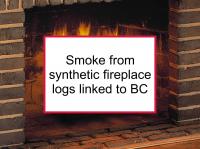Polycyclic aromatic hydrocarbons (PAHs) are chemicals that are formed during the incomplete burning of coal, oil and gas, garbage, food and other organic substances. PAHs are found in well-done or fried meat and fish, as well as vehicle exhaust and other air pollution. High levels of PAH exposure have been linked to increased breast cancer risk.
Women with high levels of PAH exposure, whether from diet or as a result of environmental factors, have been found to have higher risk of breast cancer than those with low exposure. Now a new study has reported that women who use synthetic fireplace logs have an elevated risk of breast cancer.
Ambient particulate matter and breast cancer prognosis
One 2013 California study reported that exposure to high levels of ambient particulate matter may reduce the length of survival in women with breast cancer. Ambient particulate matter consists of all the solid and liquid particles suspended in air at a given location. It includes soot, smoke, and other components of factory and automobile exhaust, as well as dust, pollen, and liquid droplets. Women with breast cancer living in areas with higher levels of ambient particulates were found to have shorter survival than those living in areas with lower exposures. The greater the exposure, the higher the risk of early death. The deleterious effect of particulate matter on survival was more pronounced among women diagnosed with early stage disease.
Latest research examines use of indoor stoves and fireplaces
The case-control study referenced at the beginning of this news story was designed to investigate the association between indoor stove or fireplace use and risk of breast cancer. The authors hypothesized that indoor stove or fireplace use would be associated with increased risk of breast cancer and vary according to the type of material burned, and the length and timing of exposure. They also predicted that the association would vary according to natural variations in certain genes (gene polymorphisms). The study included 1,508 women with breast cancer and 1,556 cancer-free controls from Long Island, New York.
Breast cancer risk was found to be heightened among women reporting ever burning synthetic fireplace logs in their homes. Synthetic logs typically are made of wood (sawdust) and other waste agricultural biomass (e.g., nut shells, fruit pits, coffee grounds), as well as paper, petroleum wax, plant oils, and small amounts of various chemicals. On the other hand, no increase in breast cancer risk was found for wood burning. Longer duration (over seven years) of synthetic log use, age over 20 at exposure, and two or more genetic variants in GSTM1, T1, A1 or P1 each were associated with increased risk. The authors comment that while wood and synthetic logs are both sources of PAH exposure when burned, only synthetic log burning was associated with increased breast cancer risk. This risk was stronger for longer exposures, exposure during adulthood, and those with multiple GST variant genotypes. The results should be interpreted with caution and require confirmation by additional studies.
